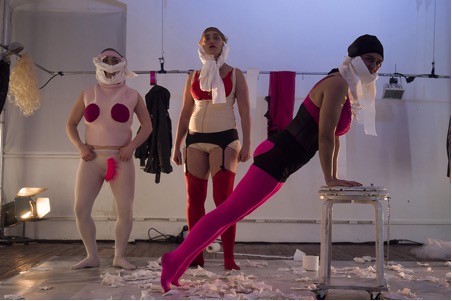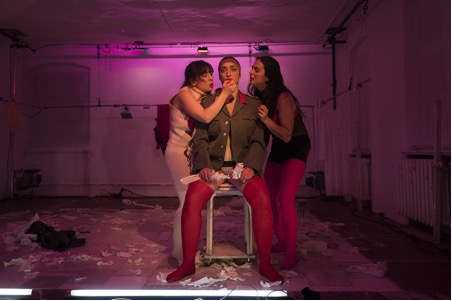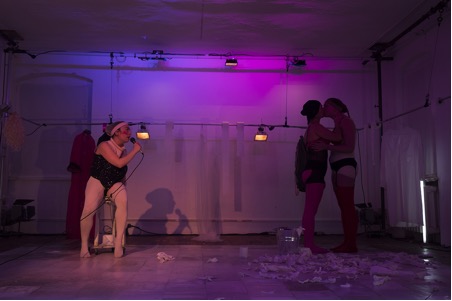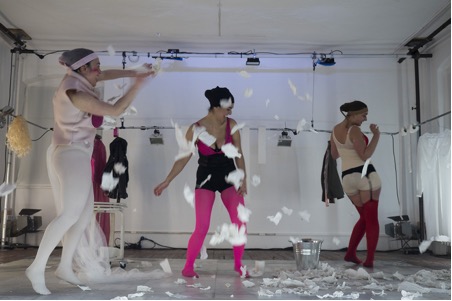Flight of the Escales is an international theatre company that creates experimental and political theatre based on the personal experiences of its team. It aims to deconstruct narratives to reach the hidden, oppressed and ignored voices in the texts. It works together with artists in a collaborative and interdisciplinary way. Sarah Calver and Caroline Ortega are the founders of the company, but there is a big multi-cultural team in the background. They mostly perform in European cities and recently performed in London on the 24th, 25th and 26th of May 2018 at the Camden People`s Theatre. As this performance mainly concerns patriarchal order, gender roles, women’s struggles and means of resistance, it is constructed with a feminist point of view.
No Way Out is a multilingual performance in which all stories are told in the performers’ mother tongues (French, Spanish and Turkish). However, even if there is an audience member who does not know one of these languages, the story makes itself clear with the body language of the performers. When the performers interact with each other, they speak in English, and at some point, all stories are told or summarized with a few sentences in English. This use of English in the London production is used to keep the audience in the loop. Therefore, there is no real language barrier. Additionally, at the entrance of the play, a leaflet is supplied to each audience member, providing explanations for the items, stories and words related to the language of the performers. This leaflet also prepares the audience for the context, which might be unclear.
How this company created the four-language text is quite interesting. The Venezuelan director of the performance, Carolina Ortega, worked in this performance together with the British co-director, Sarah Calver. They began with the idea of making a show with women, where the performers rebel against the patriarchal portrayal, characterisation and idealized images of femininity that all women have been raised with: princesses from fairy tales, media images, female characters in films, literature, theatre, etc. That is why they decided to work with women from different cultures, with different sets of cultural references, in order to enter a dialogue between women, about the things they have carried with them. Ortega and Calver asked the performers to bring at least two characters they were familiar with from their home countries, and they then worked on the stories of these characters together in the rehearsal room. They focused on the female characters they found interesting. They took the stories as they were, and they deconstructed them to find the themes they wanted to highlight. They never sat down to write a text, instead they rehearsed and tried different ways to embrace the main theme of each story. They then selected pieces that reflected their perspective.

No Way Out, Here the performers reproduce scenes of cat-calling by showing toxic masculinity behaviors in a grotesque way. Photo: Federico Boccardo / Underskin.
The stage-setting of the performance is composed mainly of a toilet, a couple of clothes items hanging randomly on a clothes rail, rolls of toilet paper, and a TV showing lots of images from everyday life, including news and programs like fashion shows. The TV showing images at the corner of the stage symbolises how women are brainwashed to fit into the gender stereotypes they have been presented to them. They are constantly told by way of the media how women should be or behave. It appears the three women are imprisoned in a toilet. Being trapped in a toilet symbolises the typical life of a woman in this male-dominated world. The patriarchy expects women to live under their given conditions, which can never be somewhere or something other than a small toilet. The performance shows how patriarchy establishes the borders it draws for women, and how it puts them under conditions expecting them to be happy and feel satisfied with whatever they are given. However, it also deconstructs this discourse by revealing that women are trying to find ways to break free of this imprisoning tiny space. Therefore, the voice of resistance is heard and underlined. Women struggle hard to break free of the patriarchal context.
The performance starts with a woman speaking French who represents Joan of Arc. Her story focuses on woman as a sublime mother figure in connection with nationalism, and how this form of being is ideologically supported by governments. The performer reveals the general attitude of nations, and the patriarchal discourse related to the idea of motherhood. However, the way the performers act and use language actually criticises this approach. For example, the patriarchal doctrine creates a sublime and sacred Joan of Arc as a figure who liberates her country, lives for her country and does nothing for herself. Finally, she is burnt alive to become a Saint. The French performer Clemence Caillouel shows the strength, determination and courage of Joan of Arc by focusing on the fact that her death was her own choice and the things she had done were only for herself. Having a go at the French nationalists for using her image, she masturbates during her text, saying that this is what she thinks of their nationalism. She declares that she didn’t want to become the Joan they wanted her to be and she wouldn’t want to be anyone else but herself.

No Way Out, The story of Joan of Arc, while her friends are trying to silence her by putting some make-up on her face. Photo: Federico Boccardo / Underskin.
The other stories are represented one-by-one in a similar way. Another story that is staged is the story of Hürmüz, from Seven Husbands for Hürmüz. It is performed by Gözde Atalay. In this story, she shows a woman who is trying to survive in a society where she’s in danger if she’s alone, or single, or independent. She questions the Arabic concept of “namus” (sexual virtue), which traps women in their biology and imprisons them in houses. Gözde performs both sides of one story. As she is trapped in a wedding veil, we see her break out of it by singing a feminist 80’s Turkish song which expresses the idea of freedom for women. Hürmüz not only appears as a woman who is trapped in the patriarchal context, she also demonstrates the fighting spirit to survive and to become independent.
Another story is told by Patricia Rodriguez from Spain. It is inspired by the play Paquita by Ernesto Caballero and was previously performed as a solo by the performer. The idea of being imprisoned is once more underlined through showing that Paquita, as a character, is trapped in the idea of “romantic love,” which is always produced and reproduced by the patriarchal ideology. Therefore, the performer shows Paquita in her own personal hell of romantic love, trapped between reciting lines from romantic movies such as When Harry et Sally, and singing sad love songs. She is trapped in that loop of excitement / suffering that the beginning and the end of relationships bring.

No Way Out, Paquita, trapped in a loop between suffering and hope, is singing a love song related to her romantic story. Photo: Federico Boccardo / Underskin
The text of the performance does not consist of stories constructed classically. On the contrary, it illustrates its major issue by means of broken stories, distorted memories and fragmentary narration. Therefore, it is an intricate and deconstructive text; the stories are told in a complex way with lots of details that create crooked and twisted images of the patriarchal order. We see performers using exaggerated brutish voices and movements in bestial manlike postures including masturbation, rape, sexual intercourse scenes and such. While one of the actresses is talking about “namus” the other two perform scenes of harassment in the background using grotesque body postures and body expressions.
The performers take turns telling their stories, and the ones who stay as side characters interact with the main performer. Sometimes they play along with the major story by expressing it or being part of it directly, sometimes they play as a counterpoint to the main character. For example, while Gözde Atalay is singing her punk song in the role of Hürmüz, the other two performers play along by singing the song’s chorus. However, the side characters in the story of Joan of Arc try to intervene in one of her speeches by trying to stop her and tell her to put some make-up on.
All of the performers use an expressionist and grotesque language to destroy the general patriarchal discourse. They deconstruct the story and use each piece of language to criticise the ideology behind the text. The word choice, body language, gestures and mimicry create this effect. All of the performers are talented, full of energy and concentrated on their roles. It is easy for them to improvise and produce new words, phrases or sentences, as the text is their creation. These three women are courageous as they really try to go deep in their stories to show how women feel in a very open way, which might be controversially seen as nasty. The only weak feature about them is their use of their voices. Despite the fact that their vocal use is in accord with the dramaturgy of the performance as it tries to twist, dash and distort the ideal images, it is so labored that it risks disturbing the concentration of the audience.
Throughout the play, performers tell their stories directly to the audience. Sometimes they ask a question staring at the audience’s faces as if they are expecting an answer. Towards the end, this turns into a kind-of interactive performance. One of the performers walks among the audience, touches them and directly talks to them.

No Way Out, The performers are mocking a music video without music by highlighting the ridiculous and grotesque representation of women in music videos and media. Photo: Federico Boccardo / Underskin.
This performance is a remarkable one because it not only criticizes the patriarchal ideology, it also shows how women resist it. Resistance seems to be the revolutionary way this postmodern age fights against the patriarchal order. It is important to emphasize and remind us about the culture of resistance in womanhood. If Flight of the Escales want their play to reproduce this culture, and help a feminine ideology or discourse get stronger, they should arrange to take this show to countries outside the European zone. It would take on a new meaning in countries like Turkey, Syria, and Iran.
Meral Harmancı has a Ph.D. in Theatre Criticism and Dramaturgy and she is a member of International Association of Theatre Critics. Her Ph.D. study was about the first female dramatists’ theatre texts between the late Ottoman period and the early years of the Republic of Turkey. After her BA in English Language and Literature, she started writing reviews and critical papers on theatre and modern dance for Turkish art magazines and online platforms.

European Stages, vol. 12, no. 1 (Fall 2018)
Editorial Board:
Marvin Carlson, Senior Editor, Founder
Krystyna Illakowicz, Co-Editor
Dominika Laster, Co-Editor
Kalina Stefanova, Co-Editor
Editorial Staff:
Joanna Gurin, Managing Editor
Maria Litvan, Assistant Managing Editor
Advisory Board:
Joshua Abrams
Christopher Balme
Maria Delgado
Allen Kuharsky
Bryce Lease
Jennifer Parker-Starbuck
Magda Romańska
Laurence Senelick
Daniele Vianello
Phyllis Zatlin
Table of Contents:
- Berlin Theatre, Fall 2017 (Part II) by Beate Hein Bennett
- Report from Berlin (June 2018) by Marvin Carlson
- Othello, Shakespeare’s New Globe by Neil Forsyth
- Resistance Through Feminist Dramaturgy: No Way Out by Flight of the Escales by Meral Hermanci
- 2018 Edinburgh Festival Fringe by Anna Jennings
- The Avignon Arts Festival 2018 (July 6 – 24): Intolerance, Cruelty and Bravery by Philippa Wehle
- Le Triomphe de l’Amour : Les Bouffes-du-Nord, Paris, June 15—July 13, 2018 by Joan Templeton
- The Kunstenfestivaldesarts 2018 of Brussels (Belgium) by Manuel García Martínez
- Somewhere Over the Rainbow: Contemporary Nordic Performance at the 2018 Arctic Arts Festival by Andrew Friedman
- A Piece of Pain, Joy and Hope: The 2018 International Ibsen Festival by Eylem Ejder
- The 2018 Ingmar Bergman International Theater Festival by Stan Schwartz
- A Conversation With Eirik Stubø by Stan Schwartz
- The Estonian Theatre Festival, Tartu 2018: A ‘Tale of the Century’ by Dr. Mischa Twitchin
- BITEF 52, World Without Us: Fascism, Democracy and Difficult Futures by Bryce Lease
- Unfamiliar Actors, New Audiences by Pirkko Koski
- Corruption, capitalism, class, memory and the staging of difficult pasts: Barcelona theatre and the summer of 2018 by Maria Delgado
- Reframing past and present: Madrid theatre 2018 by Maria Delgado
www.EuropeanStages.org
europeanstages@gc.cuny.edu
Martin E. Segal Theatre Center:
Frank Hentschker, Executive Director
Marvin Carlson, Director of Publications
©2018 by Martin E. Segal Theatre Center
The Graduate Center CUNY Graduate Center
365 Fifth Avenue
New York NY 10016
European Stages is a publication of the Martin E. Segal Theatre Center ©2018
Center:
Frank Hentschker, Executive Director
Marvin Carlson, Director of Publications
©2018 by Martin E. Segal Theatre Center
The Graduate Center CUNY Graduate Center
365 Fifth Avenue
New York NY 10016
European Stages is a publication of the Martin E. Segal Theatre Center ©2018


